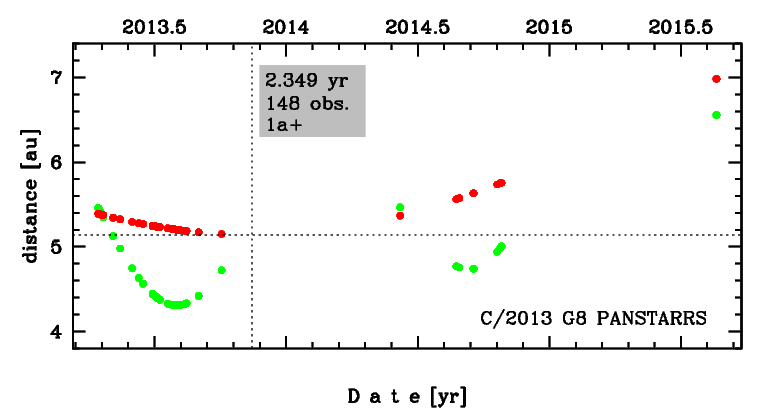C/2013 G8 PANSTARRS
more info
Comet C/2013 G8 was discovered on 14 April 2013 with Pan-STARRS 1 telescope (Haleakala), that is 7 months before its perihelion passage. It was observed until 20 August 2015.
Comet had its closest approach to the Earth on 1 August 2013 (4.318 au), about 3.5 months after discovery and 3.5 months before perihelion passage.
Solution given here is based on data spanning over 2.35 yr in a range of heliocentric distances: 5.39 au – 5.141 au (perihelion) – 6.98 au.
This Oort spike comet suffers moderate planetary perturbations during its passage through the planetary system; these perturbations lead to a more tight future orbit (see future barycentric orbits).
Comet had its closest approach to the Earth on 1 August 2013 (4.318 au), about 3.5 months after discovery and 3.5 months before perihelion passage.
Solution given here is based on data spanning over 2.35 yr in a range of heliocentric distances: 5.39 au – 5.141 au (perihelion) – 6.98 au.
This Oort spike comet suffers moderate planetary perturbations during its passage through the planetary system; these perturbations lead to a more tight future orbit (see future barycentric orbits).
| solution description | ||
|---|---|---|
| number of observations | 148 | |
| data interval | 2013 04 14 – 2015 08 20 | |
| data type | perihelion within the observation arc (FULL) | |
| data arc selection | entire data set (STD) | |
| range of heliocentric distances | 5.39 au – 5.14 au (perihelion) – 6.98 au | |
| detectability of NG effects in the comet's motion | NG effects not determinable | |
| type of model of motion | GR - gravitational orbit | |
| data weighting | YES | |
| number of residuals | 284 | |
| RMS [arcseconds] | 0.21 | |
| orbit quality class | 1a+ | |
| next orbit statistics, both Galactic and stellar perturbations were taken into account | ||
|---|---|---|
| no. of returning VCs in the swarm | 5001 | * |
| no. of escaping VCs in the swarm | 0 | |
| no. of hyperbolas among escaping VCs in the swarm | 0 | |
| next reciprocal semi-major axis [10-6 au-1] | 364.29 – 365.55 – 366.84 | |
| next perihelion distance [au] | 5.14856 – 5.14856 – 5.14857 | |
| next aphelion distance [103 au] | 5.447 – 5.466 – 5.485 | |
| time interval to next perihelion [Myr] | 0.1419 – 0.1427 – 0.1435 | |
| percentage of VCs with qnext < 10 | 100 | |
| next_g orbit statistics, here only the Galactic tide has been included | ||
|---|---|---|
| no. of returning VCs in the swarm | 5001 | * |
| no. of escaping VCs in the swarm | 0 | |
| no. of hyperbolas among escaping VCs in the swarm | 0 | |
| next reciprocal semi-major axis [10-6 au-1] | 364.30 – 365.56 – 366.85 | |
| next perihelion distance [au] | 5.14097 – 5.14099 – 5.14101 | |
| next aphelion distance [103 au] | 5.447 – 5.466 – 5.485 | |
| time interval to next perihelion [Myr] | 0.142 – 0.1427 – 0.1434 | |
| percentage of VCs with qnext < 10 | 100 | |
